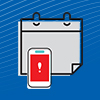Blog
Four ways to save your hospital money with better healthcare communications
The rising costs of delivering care along with shrinking operating margins means that cost reduction is a constant initiative at hospitals and health systems across the United States. Healthcare delivery organizations are evaluating everything from tighter supply controls to energy efficiency initiatives.
Hospitals are also assessing healthcare communications, and rightly so. Research shows that inefficient communications cost U.S. hospitals up to $12 billion per year, which breaks down to nearly $4 million annually for a 500-bed hospital.
Why are inefficiencies in communication so expensive? They waste clinician time, delay patient treatment and discharge, and can contribute to costly medical errors.
Video: See how VCU Health uses enterprise-wide communications
Let’s dive into four ways hospitals can save money with better communications.
1. Time is money
The old saying is tried-and-true. Studies examining how hospitalists spend their time reveal that a quarter of every shift is devoted to communications, nearly half of which is to collaborate with other physicians. The time clinicians spend just trying to communicate with one another takes their valuable attention away from other, more important activities. By reducing the amount of time clinicians spend searching for their colleagues’ phone numbers or waiting to be connected through hospital operators and paging systems, hospitals could decrease this administrative task and give physicians more time to treat and interact with their patients. These tasks are a major contributor to physician burnout.
Faster communications will help save clinical time as well as speed up admissions, treatment, and discharge through better coordinated information exchange among clinicians, transport, and housekeeping staff. Better communication leads to better care coordination.
One way to accomplish this type of time savings is to arm staff with better communication tools. Smartphones have been a big step forward for mobile workflows, but the devices alone are not enough. The ability to access colleague contact information, up-to-date on-call schedules, and secure messaging channels is key to making these devices efficient. Including actionable information in secure, text-based communications with the correct clinician is a valuable time saver. This supports fast, meaningful interactions and reduces voicemail tag and even phone conversations.
2. Decrease length of stay
Breakdowns in the communication of important information to the right people during the discharge process can lead to significant delays, which in turn increase the patients’ average length of stay. Research estimates 53% of wasted cost comes from increased length of stay, at a cost of $2.45 million per year for a 500-bed hospital.
Faster communications among care team members, such as secure texting between hospitalists and nursing staff, is one way to recapture some of this wasted time and cost by speeding the discharge process. Faster, more efficient patient discharge also has the potential to increase patient satisfaction scores by providing a positive final impression for the patient.
3. Support better patient outcomes
Using a clinical alerting solution to integrate a variety of patient care and monitoring systems with staff’s Wi-Fi phones, smartphones, pagers, and/or voice badges, speeds notification and response times to important alerts from patient monitoring equipment. Not only does this promote better patient outcomes, it can also reduce the number of unnecessary alarms to prevent nurses and caregivers from alarm fatigue.
Using communication to provide better patient outcomes is critical during a life-threatening emergency. There are two key components of coordinating a care team during an emergency:
- Quickly notifying the right providers, and
- Tracking their acknowledgments to ensure an appropriate level of response.
Both tasks can be accomplished with a robust emergency notification solution. Instead of spending valuable time manually working through a call-tree or sending individual pages to each member of a response team, the entire process can be launched with one touch. Whether triggering a code blue or calling on-call staff to the hospital to handle a large influx of patients, emergency notification software can alert the correct responders on their preferred devices.
One way this solution is being used by hospitals is to facilitate code STEMIs and coordinate the 30 or more staff required for successful average door-to-balloon times of 90 minutes or less.
Franciscan Health Michigan City cut code initiation in half. Learn how.
4. Improve patient satisfaction
The efficiency of healthcare communications also contributes to patient satisfaction, which can directly and indirectly impact a hospital’s bottom line. Indirectly, communications shape a patient’s experience, which contributes to a facility’s perceived brand in the community. If patients have a choice of where to go for care, that brand can bring more patients to a hospital, or send them to the competition.
There are also more direct ways communications can influence hospital costs. They can impact patient satisfaction scores, measured by the HCAHPS survey. HCAHPS scores are directly tied to Medicare reimbursements that are allocated only to the high-scoring facilities.
Hospitals exist to improve the lives of their patients through the care they deliver. But they are also tasked with providing their services in the most efficient and effective ways possible. This means evaluating all the possible ways to control and reduce costs using the latest technologies and workflow processes. Improved communications are within reach for hospitals that are able to take a step back and look at how all members of their staff interact to provide care—and how they could do this better at every turn. There are significant efficiencies and cost savings to be had through intuitive solutions that reduce length of stay and improve the handoff of patient information as shifts, staff, and events change.





